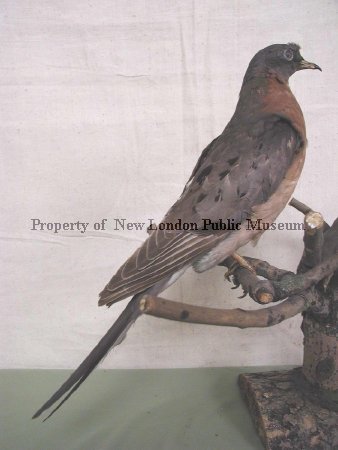Object ID:
1917.1.159
Collection:
Carr Natural History
Object Name:
Specimen, Taxidermied
Description:
Passenger Pigeon. Male. Extinct. Double mount with female. The head and upper parts of the male pigeon were a clear bluish gray with black streaks on the scapulars and wing coverts. Patches of pinkish iridescence at the sides of the throat changed in color to a shining metallic bronze, green, and purple at the back of the neck. The lower throat and breast were a soft rose, gradually shading to white on the lower abdomen. The irides were bright red; the bill small, black and slender; the feet and legs a clear lake red. The range of the passenger pigeon in its migrations was from central Ontario, Quebec, and Nova Scotia south to the uplands of Texas, Louisiana, Alabama, Georgia, and Florida. Only a few birds were ever reported as far west as the Dakotas. The main nesting area was in the region of the Great Lakes and east to New York. The main wintering sites stretched from Arkansas to North Carolina south to the uplands of the Gulf Coast states. The habitat of the passenger pigeon was mixed hardwood forests. The birds depended on the huge forests for their spring nesting sites, for winter "roosts," and for food. The mainstays of the passenger pigeon's diet were beechnuts, acorns, chestnuts, seeds, and berries found in the forests. Worms and insects supplemented the diet in spring and summer.
Kingdom:
Animalia (Animals)
Phylum:
Chordata (Chordates)
Class:
Aves (Birds)
Natural History Order:
Columbiformes
Family:
Columbidae (Pigeons)
Date:
1890

